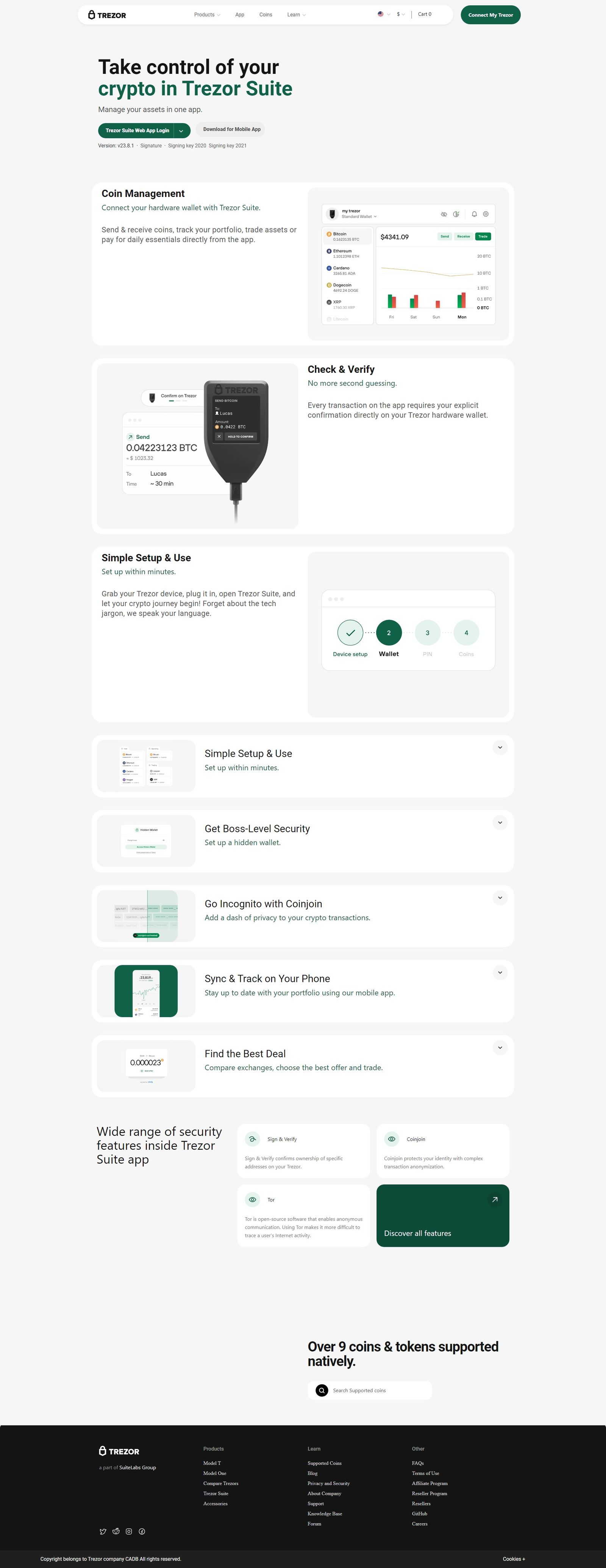
Trézor Suite: The Ultimate Guide to Secure Cryptocurrency Management
Introduction to Trézor Suite:
In the fast-evolving world of cryptocurrencies, security and ease of use are paramount. Trézor Suite, developed by SatoshiLabs, emerges as a robust solution designed to simplify crypto management while prioritizing safety. Tailored for both beginners and seasoned investors, this platform integrates seamlessly with Trezor hardware wallets, offering a unified interface to store, send, and receive digital assets. Whether you’re safeguarding Bitcoin or managing Ethereum, Trézor Suite combines cutting-edge technology with user-friendly design.
What is Trézor Suite?
Trézor Suite is a software application that acts as the command center for Trezor hardware wallets. Unlike traditional crypto wallets, it emphasizes offline storage (cold storage) to protect funds from online threats. Available as a desktop app and web interface, it supports over 1,000 cryptocurrencies, including Bitcoin, Ethereum, and Litecoin. Beyond basic transactions, it offers portfolio tracking, privacy tools, and advanced security features, making it a one-stop solution for crypto enthusiasts.
Key Features of Trézor Suite
- Hardware Wallet Integration: Directly connects to Trezor devices (Model T and One) for secure offline transactions.
- Cross-Platform Compatibility: Accessible via Windows, macOS, Linux, and browsers like Chrome and Firefox.
- Portfolio Dashboard: Track real-time balances, historical performance, and market trends.
- CoinJoin Support: Enhance privacy by mixing Bitcoin transactions with others.
- Custom Fees: Optimize transaction speeds and costs during network congestion.
- Fiat Currency Conversion: View holdings in USD, EUR, or other local currencies.
- Password Manager: Securely store credentials using Trezor’s encryption.
- Tor Integration: Route transactions through the Tor network for anonymity.
Why Trézor Suite Stands Out
While many wallets focus solely on convenience, Trézor Suite balances usability with uncompromising security. Its open-source code allows transparency, letting users and developers audit the software. Additionally, features like Shamir Backup (recovery seed splitting) and two-factor authentication (2FA) add extra layers of protection. For those prioritizing privacy, CoinJoin and Tor compatibility ensure transactions remain untraceable.
Getting Started with Trézor Suite
- Purchase a Trezor Device: Choose between Model T (touchscreen) or One (button-based).
- Download the Suite: Install the desktop app or access the web version at suite.trezor.io.
- Connect Your Device: Use a USB cable to link your Trezor hardware wallet.
- Create a Wallet: Follow on-screen instructions to set up a new wallet or restore an existing one.
- Explore Features: Navigate the dashboard to send/receive crypto, track portfolios, or enable privacy tools.
Security Measures in Trézor Suite
- Offline Private Keys: Private keys never leave the Trezor device, shielding them from hackers.
- PIN Protection: Each session requires a device-specific PIN.
- Firmware Updates: Regular updates patch vulnerabilities and introduce new features.
- Phishing Resistance: The Suite verifies transaction details on the device screen, preventing tampering.
Compatibility and Accessibility
Trézor Suite supports Windows 10+, macOS 10.12+, and Linux distributions. Mobile users can access limited features via Trezor’s web interface on Android and iOS. Browser extensions like MetaMask also integrate with Trezor devices, enabling decentralized app (dApp) interactions securely.
Trézor Suite vs. Competitors
Compared to Ledger Live or Exodus, Trézor Suite excels in privacy and open-source transparency. While Ledger offers a mobile app, Trezor’s focus on air-gapped security appeals to users wary of online threats. Exodus, though user-friendly, lacks native hardware wallet integration, making Trézor Suite a safer choice for large holdings.
Conclusion
Trézor Suite redefines crypto management by merging intuitive design with enterprise-grade security. Its synergy with Trezor hardware wallets ensures your assets remain safe, while features like CoinJoin and Tor support cater to privacy-conscious users. Whether you’re a HODLer or active trader, this platform offers the tools needed to navigate the crypto landscape confidently.
10 FAQs About Trézor Suite
1. Is Trézor Suite free to use?
Yes, Trézor Suite is completely free. You only need a Trezor hardware wallet to unlock its full features.
2. Can I use Trézor Suite without a Trezor device?
No, the Suite requires a Trezor hardware wallet to manage transactions securely.
3. Which cryptocurrencies does Trézor Suite support?
It supports 1,000+ coins, including BTC, ETH, ADA, and ERC-20 tokens.
4. How does Trézor Suite enhance privacy?
It offers CoinJoin for Bitcoin and Tor integration to anonymize transactions.
5. Is Trézor Suite mobile-friendly?
A limited web version works on mobile browsers, but a dedicated app is unavailable.
6. How secure is the recovery seed?
Shamir Backup lets you split the seed into multiple parts, reducing theft risks.
7. Can I stake cryptocurrencies via Trézor Suite?
Currently, staking isn’t supported, but you can connect to third-party staking platforms.
8. Are firmware updates mandatory?
While optional, updates are recommended to maintain security and functionality.
9. Does Trézor Suite work with MetaMask?
Yes, connect your Trezor to MetaMask for secure dApp interactions.
10. What if I lose my Trezor device?
Use your recovery seed to restore your wallet on a new Trezor hardware wallet.